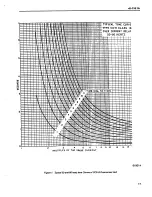
41-116.1A
2
magnet result in out-of-phase fluxes in the air gap.
The out-of-phase air gap fluxes produced cause a
contact closing torque.
2.2. INDICATING CONTACTOR SWITCH UNIT
(ICS)
The indicating contactor switch is a small dc oper-
ated clapper type device. A magnetic armature, to
which leaf-spring mounted contacts are attached, is
attracted to the magnetic core upon energization of
the switch. When the switch closes, the moving con-
tacts bridge two stationary contacts, completing the
trip circuit. Also during this operation two fingers on
the armature deflect a spring located on the front of
the switch, which allows the operation indicator target
to drop. The target is reset from the outside of the
case by a push rod located at the bottom of the
cover.
The front spring, in addition to holding the target, pro-
vides restraint for the armature and thus controls the
pickup value of the switch.
2.3. INDICATING INSTANTANEOUS TRIP UNIT
(IIT)
The instantaneous trip unit is a small ac operated
clapper type device. A magnetic armature, to which
leaf-spring mounted contacts are attached, is
attracted to the magnetic core upon energization of
the switch. When the switch closes, the moving con-
tacts bridge two stationary contacts completing the
trip circuit. Also during the operation two fingers on
the armature deflect a spring located on the front of
the switch which allows the operation indicator target
to drop. The target is reset from the outside of the
case by a push rod at the bottom of the cover.
A core screw accessible from the top of the switch
provides the adjustable pickup range.
2.4. VOLTAGE UNIT (V)
The voltage unit is an induction type cylinder type
unit.
Mechanically, the voltage unit is composed of four
basic components: A die-cast aluminum frame, an
electromagnet, a moving element assembly, and a
molded bridge.
The frame serves as the mounting structure for the
electromagnet and for a magnetic core. The mag-
netic core houses the lower pin bearing and is
secured to the frame by a locking nut. The bearing
can be replaced if necessary, without having to
remove the magnetic core from the frame.
The electromagnet has two pairs of voltage coils.
Each pair of diametrically opposed coils is connected
in series. In addition, one pair is in series with an
adjustable resistor. These sets are paralleled as
shown in Figure 2. The adjustable resistor serves not
only to shift the phase angle of the one flux with
respect to the other to produce torque, but it also pro-
vides a dropout adjustment.
Locating pins in the electromagnet are used to accu-
rately position the lower pin bearing, which is
mounted on the frame, with respect to the upper pin
bearing, which is threaded into the bridge. The elec-
tromagnet is secured to the frame by four mounting
screws.
The moving element assembly consists of a spiral
spring, contact carrying member, and an aluminum
cylinder assembled to a molded hub which holds the
shaft. The shaft has removable top and bottom jewel
bearings. The shaft rides between the bottom pin
bearing and the upper pin bearing with the cylinder
rotating in an air gap formed by the electromagnet
and the magnetic core. The stops for the moving ele-
ment contact arm are an integral part of the bridge.
The bridge is secured to the electromagnet and
frame by two mounting screws. In addition to holding
the upper pin bearing, the bridge is used for mount-
ing the adjustable stationary contact housing. The
stationary contact housing is held in position by a
spring type clamp. The spring adjuster is located on
the underside of the bridge and is attached to the
moving contact arm by a spiral spring. The spring
adjuster is also held in place by a spring type clamp.
With the contacts closed, the electrical connection is
made through the stationary contact housing clamp,
to the moving contact, through the spiral spring out to
the spring adjuster clamp.
3. CHARACTERISTICS
To prevent the relay from operating for currents
above the overcurrent unit pickup, the voltage unit
contact is connected to control the telephone relay
whose contacts are connected in the shading coil cir-
cuit of the overcurrent unit. The voltage contact is
held open at voltage above the set point, to prevent



































